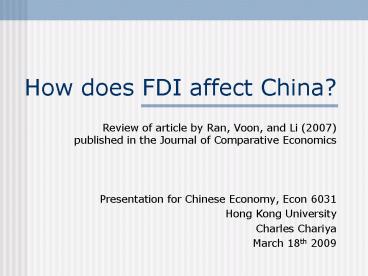How does FDI affect China - PowerPoint PPT Presentation
1 / 18
Title:
How does FDI affect China
Description:
East/Coastal regions benefit from domestic investments, human capital, and ... in fact be more of an inertial force with the 'East/Coast' getting the gains ... – PowerPoint PPT presentation
Number of Views:81
Avg rating:3.0/5.0
Title: How does FDI affect China
1
How does FDI affect China?
- Review of article by Ran, Voon, and Li (2007)
published in the Journal of Comparative Economics - Presentation for Chinese Economy, Econ 6031
- Hong Kong University
- Charles Chariya
- March 18th 2009
2
Agenda
- Overview and Background
- What is FDI?
- FDI by Country
- Paper Goals
- Regression Model and Other Variables
- Results
- Analysis and Interpretation
- Conclusion
3
Overview What is FDI?
- A company from one country making a physical
investment into building a factory in another
country. It is the establishment of an enterprise
by a foreigner. - In order to qualify as FDI the investment must
afford the parent enterprise control over its
foreign affiliate. - The IMF defines control as owning 10 or more of
the ordinary shares or voting power of an
incorporated firm or its equivalent for an
unincorporated firm - Lower ownership shares are known as portfolio
investment
4
Background - History of FDI
- After the Second World War, global FDI was
dominated by the United States - The US accounted for around 75 of new FDI
between 1945 and 1960 - FDI has grown in importance in the global economy
with FDI stocks now constituting 28 percent of
global GDP
Source Bureau of Economic Analysis, U.S.
International Transactions Accounts Data (2008)
5
Background Cross Country FDI
- US Tops both lists in 2008
- China (both HK and mainland) are the highest net
receivers of FDI in 2008
Source Stock of Direct Foreign Investment, CIA
The World Factbook (2008)
6
How does FDI affect ChinaPaper Goals
- Examine the traditional spillover effect of FDI
in China - Observe the effect of FDI on local industries
without foreign participation - Study the effect of FDI in China across
industries and provinces
7
Data Source and Details
- The China Industry Economy Statistical Yearbook
- Years 2002, 2003, and 2004
- Dept. of Industry and Transportation, National
Statistics Bureau - FDI in actual amounts
- Comprehensive data for 19 industries and 30
provinces (excluding Taiwan and Tibet) - Total of 1710 observations
- 1394 observations with some FDI
- 316 with no FDI (domestic investment only)
8
Regression Model
9
Regression Model
10
Variable WeightingsModel Variations
Weighted by Relative Physical Capital
Weighted by Relative Employment
No Weighting
FIA Foreign ownership industry average Foreign
equity participation averaged over all the same
industries across different provinces
FRA Foreign ownership regional average
11
Sample FIA/FRA calculation
12
Regression Results (Combined)
Note The Models refer to the weightings which
dont appear to greatly affect the General Least
Squares results
13
Regression Results (FDI/Local)
Note Without FDI, the F term becomes 0, thus all
interaction terms also drop out
14
Regression Results (FDI/Local)
Note Without FDI, the F term becomes 0, thus all
interaction terms also drop out
15
Net Impact AnalysisCalculating the effect of FDI
by Region
- The authors use a reverse method of calculating
the net productivity gains by FDI by region. - Results show that some regions may have a
negative result as a result of investment. - Shanghai, Guangdong, and Jiangsu are best at
utilizing FDI.
16
Conclusions
- China does not appear to get big net gains from
FDI inflow - Small magnitudes of estimated FDI coefficient and
Negative net impacts are reported for many
industries and provinces - Developed regions benefit more from FDI inflow at
the cost of backward regions - East/Coastal regions benefit from domestic
investments, human capital, and natural resources - Note The authors do additional validation of the
model using Instrumental Variables (lagged FDI,
Exchange Rates), but results are similar to what
we saw previously.
17
Critical Analysis
- Although the authors review the presence/lack of
FDI, they dont really examine why some regions
have FDI and others dont - Easier to access areas
- Region-specific Issues
- Companies that invest FDI have specific
needs/goals - Authors argue there is an FDI propitious effect,
however this may in fact be more of an inertial
force with the East/Coast getting the gains - Regions with low efficiency require more
investment to equalize - Regions that are well built out (infrastructure,
development) will continue to benefit from easy
returns on FDI
18
Questions? Comments?!
?
Thank you for listening!































